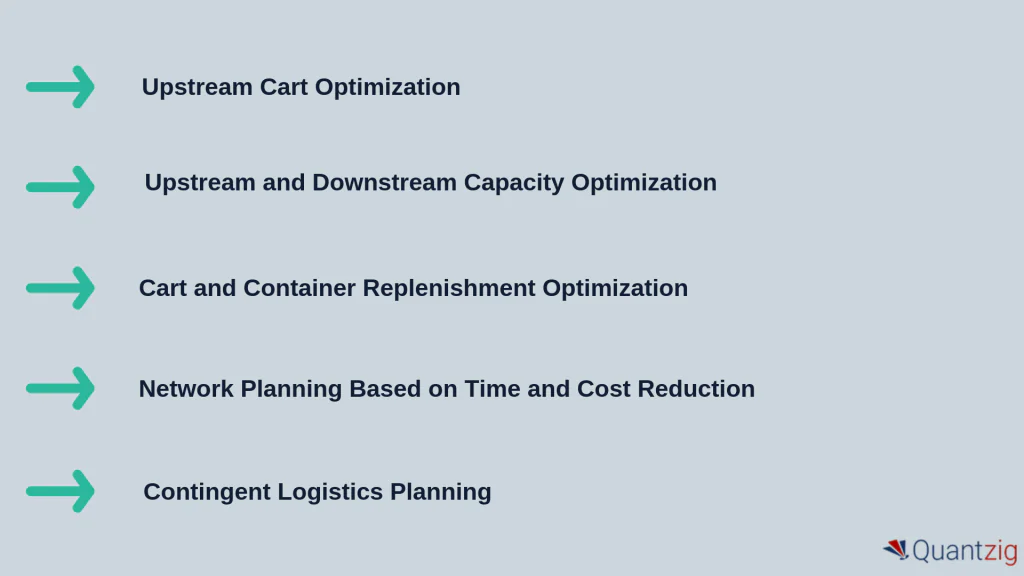Table of Contents
What You’ll Find in this Supply Chain Analytics Case Study:
- Industry Overview
- The Business Challenge
- Solutions Offered and Value Delivered
- Our Supply Chain Network Optimization Capabilities
Industry Overview
A leading food manufacturing company in the U.S was facing several operational and supply chain challenges due to the growing complexity of its supply network. Serving millions of customers across the globe and sourcing its raw material from a number of suppliers, the company was also rapidly scaling up its online sales. Rapid expansions along with M&A’ presented several operational and network optimization challenges for the manufacturer. This is when they approached Quantzig to leverage its expertise to redesign its supply chain to manage complexity and boost overall performance.
Book a demo to experience the meaningful insights we derive from data through our analytical tools and platform capabilities. Schedule a demo today!
Book a demoThe Business Challenge
The impact of supply chain operations on procurement cost and service efficiency has made it crucial for businesses to optimize the flow of products and goods within their supply network. Today, most businesses are busy focusing on improving service levels and reducing working capital across the end-to-end distribution network and fail to align their network optimization programs with long-term business goals.
Supply chain network optimization initiatives provide the ability to determine the costs and benefits of adopting a company’s overall network in response to such changes. At Quantzig, we focus on developing dynamic supply chain network optimization capabilities that align the network to long-term business goals, while empowering businesses to evaluate their assets on an ongoing basis.
With highly perishable products and a large number of SKU’s driving complexity, a U.S. food manufacturing company was looking to assess their existing operations to determine the optimal number of warehouses that would help them fulfill customer demand and minimize distribution costs. They approached Quantzig to leverage its network optimization capabilities to address key challenges pertaining to logistics and overall fulfillment costs.
Solutions Offered and Value Delivered
Quantzig’s analytics experts worked closely with the client to understand the company’s profitability targets and growth ambitions. The key phases of this engagement included a detailed evaluation of current business performance, recommendations for improving operations, a pilot phase, and a final implementation. Analyzing and extracting insights from the client’s internal supply chain data helped us uncover several cost-saving opportunities during the evaluation phase.
Our supply chain network optimization solutions also empowered the client to:
- Enhance value creation through the use of more systematic order management systems
- Achieve significant improvements in performance by shortening the internal clearance processes
- Reduce inventory costs by 65%
Experience the advantages firsthand by testing a customized complimentary pilot designed to address your specific requirements. Pilot studies are non-committal in nature.
Request a Free PilotImpacts of Supply Chain network optimization
Supply chain network optimization has profound impacts on businesses, influencing various facets from cost efficiency to customer satisfaction. Here are four key impacts elucidated:
- Enhanced Operational Efficiency: Implementing advanced analytics and optimization techniques streamlines warehouse expenses and supply chain networks, improving product availability and delivery speed. The executives can make end-to-end decisions with greater precision, utilizing insights from complex network modeling. This optimization reduces excess capacity, mitigates shortages, and enables quicker transit times, leading to optimized operational details and consolidated footprints. As a result, organizations experience improved bottom-line numbers and heightened competitiveness in the market.
- Improved Agility and Responsiveness: By incorporating optimization-derived designs and employing deep reinforcement learning, businesses can adapt to rapid demand growth and unforeseen disruptions such as breaks in supply or intermittent production. With continuous improvements and incremental changes, the supply chain becomes more resilient to fluctuations, ensuring uninterrupted service and meeting cutoffs for next-day delivery. This enhanced agility allows companies to capitalize on opportunities and maintain customer satisfaction amidst dynamic market conditions.
- Strategic Decision Making: Multi-objective network optimization aligns organizational objectives with supply chain configurations, facilitating strategic growth initiatives and future expansion plans. By considering combinatorial decision complexity and employing physics-inspired graph neural networks, businesses can develop unconstrained capacity networks capable of supporting future growth strategies. This strategic alignment ensures that organizational structures are optimized to support sequential value-adding stages, fostering sustainable growth and competitive advantage.
- Technological Advancement and Innovation: Leveraging operations research-based tools and incorporating emerging technologies such as combinatorial optimization with graph neural networks, businesses propel innovation within the supply chain domain. This innovation extends beyond traditional problems, tackling complexities with novel approaches and fostering a culture of continuous improvement. By embracing cutting-edge methodologies, organizations unlock new avenues for optimization, driving efficiency gains and staying at the forefront of supply chain management practices.
Optimization techniques and technology
Optimization techniques and technology play a pivotal role in transforming supply chain operations, enhancing efficiency, and driving competitive advantage. Here are five key pointers highlighting the utilization of optimization techniques and technology:
- Advanced Analytics for Data-Driven Insights: Leverage advanced analytics to harness the vast amounts of data generated within supply chain networks. Utilize techniques such as network modeling and deep reinforcement learning to analyze operational details, identify patterns, and make informed decisions. By employing sophisticated algorithms, businesses can uncover optimization opportunities, mitigate risks, and enhance overall supply chain performance. Thought leadership in the field of advanced analytics enables organizations to stay ahead of the curve and leverage data as a strategic asset.
- Multi-Objective Network Optimization: Embrace multi-objective network optimization approaches to balance conflicting goals and objectives within the supply chain. With billions of granular decisions to consider, organizations must optimize across various dimensions such as product availability, delivery speed, and cost efficiency. By employing optimization techniques tailored to address combinatorial decision complexity, businesses can achieve synergies and trade-offs that align with overall strategic objectives. This enables supply chain executives to make informed end-to-end decisions that optimize the bottom line while ensuring customer satisfaction.
- Integration of Cutting-Edge Technologies: Integrate cutting-edge technologies such as Combinatorial Optimization with Physics-Inspired Graph Neural Networks to tackle highly complex supply chain networks. These technologies enable organizations to model and optimize supply chain configurations with unprecedented accuracy and efficiency. By harnessing the power of machine learning and graph neural networks, businesses can address traditional supply chain problems like the Traveling Salesperson Problem and optimize derived supply chain network designs for maximum effectiveness. This integration empowers organizations to stay agile and responsive in the face of evolving market dynamics.
- Continuous Improvement through Operations Research-Based Tools: Embrace operations research-based tools to drive continuous improvement and innovation within the supply chain. These tools provide a systematic approach to identifying optimization opportunities, evaluating alternative scenarios, and making data-driven decisions. By leveraging optimization techniques and technologies, businesses can address network optimization complexities and enhance supply chain resilience. This enables organizations to adapt to rapid demand growth, mitigate breaks in supply, and improve overall operational efficiency.
- Strategic Alignment with Organizational Objectives: Ensure that optimization techniques and technology are aligned with broader organizational objectives and future growth strategies. By integrating optimization-driven supply chain network designs with the supply chain organizational structure, businesses can create a cohesive framework for decision-making and resource allocation. This alignment fosters organizational objectives alignment and enables supply chain executives to make overall decisions that optimize the end-to-end supply chain while driving sustainable growth and competitive advantage.
How can you achieve supply chain network optimization?
Achieving supply chain network optimization requires a comprehensive approach that integrates various strategies and technologies. Here are five key pointers elucidating the steps towards achieving optimization:
- Utilize Advanced Analytics and Technologies: Leverage advanced analytics and technologies such as deep reinforcement learning and operations research-based tools to analyze supply chain networks thoroughly. By employing tools like Combinatorial Optimization with Physics-Inspired Graph Neural Networks, businesses can model complex networks, identify bottlenecks, and uncover optimization opportunities. This data-driven approach enables organizations to make informed decisions based on granular details, enhancing efficiency and performance across the supply chain.
- Streamline Operational Processes: Focus on streamlining operational processes to improve delivery speed and product availability. Optimize inbound and outbound delivery options, utilize distributed storage networks, and explore different transport modes to minimize transit times and maximize efficiency. Consolidate manufacturing batches and transport units to reduce excess capacity and minimize shortages, ensuring a more responsive and agile supply chain.
- Align Organizational Objectives: Ensure alignment between organizational objectives and supply chain configurations. Develop a clear future growth strategy and organizational model that supports sequential value-adding stages. Align supply chain organizational structures with business goals to optimize decision-making processes and resource allocation, fostering synergy and cohesion across the organization.
- Continuous Improvement and Adaptation: Embrace a culture of continuous improvement and adaptation to address evolving challenges and opportunities. Implement incremental network changes based on feedback, market trends, and technological advancements. Conduct regular network stress testing to identify vulnerabilities and proactively mitigate risks associated with rapid demand growth, breaks in supply, or intermittent production.
- Monitor Performance Metrics: Establish key performance metrics and regularly monitor bottom-line numbers to gauge the effectiveness of the efforts. Analyze quarterly business reports to track progress, identify areas for improvement, and make data-driven decisions. By monitoring performance metrics closely, supply chain executives can make informed, end-to-end decisions that drive operational excellence and contribute to overall business success.
Our Supply Chain Network Optimization Capabilities
Quantzig is a leading provider of advanced analytics and consulting services, particularly known for its expertise in supply chain optimization. Let’s break down each point to explain how Quantzig implements supply chain optimization techniques:
- Upstream Cart Optimization: Quantzig employs advanced algorithms and optimization models to streamline upstream cart operations within supply chains. By analyzing factors such as order volumes, product availability, and warehouse layout, our team optimizes cart routing and replenishment processes. This ensures that carts are efficiently utilized, reducing unnecessary movements and minimizing labor costs while maintaining optimal product availability.
- Upstream and Downstream Capacity Optimization: Quantzig specializes in optimizing both upstream and downstream capacities within supply chains. Through sophisticated mathematical modeling and simulation techniques, we determine the optimal capacity levels for various stages of the supply chain, from production facilities to distribution centers. This optimization ensures that resources are allocated efficiently, minimizing bottlenecks and maximizing throughput while balancing costs and service levels.
- Cart and Container Replenishment Optimization: Our analytics experts develop advanced replenishment strategies for carts and containers within supply chain operations. By analyzing factors such as order patterns, lead times, and storage constraints, we optimize replenishment schedules to ensure timely availability of carts and containers at key points in the supply chain. This optimization minimizes stockouts, reduces inventory holding costs, and improves overall operational efficiency.
- Network Planning based on Time and Cost Reduction: We conduct network planning exercises focused on reducing both time and cost within supply chains. Leveraging optimization algorithms and heuristic approaches, we design supply chain networks that minimize transportation lead times, warehousing costs, and overall supply chain cycle times. This optimization enhances customer service levels, reduces working capital requirements, and improves overall supply chain competitiveness.
- Contingent Logistics Planning: Our team develops contingent logistics plans to mitigate risks and uncertainties within supply chains. By leveraging scenario analysis and simulation techniques, we identify potential disruptions and develops response strategies to minimize their impact. This may involve dynamic routing of shipments, alternative sourcing strategies, or inventory pre-positioning to ensure continuity of operations during unforeseen events.
Overall, Quantzig’s supply chain optimization techniques are characterized by their data-driven approach, advanced analytics capabilities, and focus on delivering tangible business outcomes such as cost savings, improved service levels, and enhanced operational resilience.
Adopting a structured approach to supply chain network optimization can help businesses to tackle network complexities and achieve substantial reductions in inventory costs. Get started with your complimentary trial today and delve into our platform without any obligations. Explore our wide range of customized, consumption driven analytical solutions services built across the analytical maturity levels.
Start your Free Trial today


